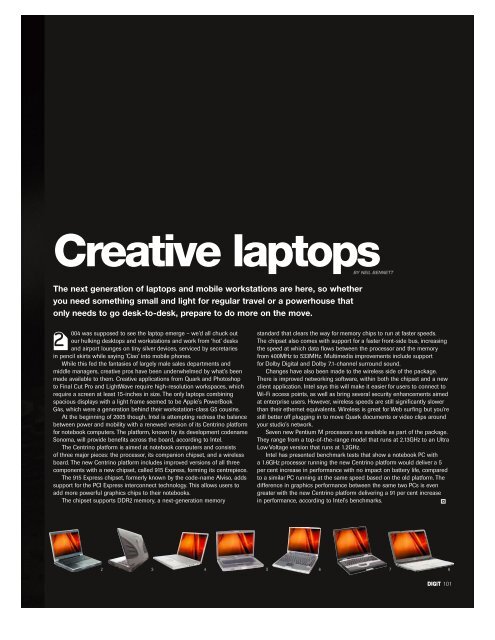You also want an ePaper? Increase the reach of your titles
YUMPU automatically turns print PDFs into web optimized ePapers that Google loves.
Creative laptops<br />
BY NEIL BENNETT<br />
The next generation of laptops and mobile workstations are here, so whether<br />
you need something small and light for regular travel or a powerhouse that<br />
only needs to go desk-to-desk, prepare to do more on the move.<br />
2<br />
0<strong>04</strong> was supposed to see the laptop emerge – we’d all chuck out<br />
our hulking desktops and workstations and work from ‘hot’ desks<br />
and airport lounges on tiny silver devices, serviced by secretaries<br />
in pencil skirts while saying ‘Ciao’ into mobile phones.<br />
While this fed the fantasies of largely male sales departments and<br />
middle managers, creative pros have been underwhelmed by what’s been<br />
made available to them. Creative applications from Quark and Photoshop<br />
to Final Cut Pro and LightWave require high-resolution workspaces, which<br />
require a screen at least 15-inches in size. The only laptops <strong>com</strong>bining<br />
spacious displays with a light frame seemed to be Apple’s PowerBook<br />
G4s, which were a generation behind their workstation-class G5 cousins.<br />
At the beginning of <strong>2005</strong> though, Intel is attempting redress the balance<br />
between power and mobility with a renewed version of its Centrino platform<br />
for notebook <strong>com</strong>puters. The platform, known by its development codename<br />
Sonoma, will provide benefits across the board, according to Intel.<br />
The Centrino platform is aimed at notebook <strong>com</strong>puters and consists<br />
of three major pieces: the processor, its <strong>com</strong>panion chipset, and a wireless<br />
board. The new Centrino platform includes improved versions of all three<br />
<strong>com</strong>ponents with a new chipset, called 915 Express, forming its centrepiece.<br />
The 915 Express chipset, formerly known by the code-name Alviso, adds<br />
support for the PCI Express interconnect technology. This allows users to<br />
add more powerful graphics chips to their notebooks.<br />
The chipset supports DDR2 memory, a next-generation memory<br />
standard that clears the way for memory chips to run at faster speeds.<br />
The chipset also <strong>com</strong>es with support for a faster front-side bus, increasing<br />
the speed at which data flows between the processor and the memory<br />
from 400MHz to 533MHz. Multimedia improvements include support<br />
for Dolby <strong>Digit</strong>al and Dolby 7.1-channel surround sound.<br />
Changes have also been made to the wireless side of the package.<br />
There is improved networking software, within both the chipset and a new<br />
client application. Intel says this will make it easier for users to connect to<br />
Wi-Fi access points, as well as bring several security enhancements aimed<br />
at enterprise users. However, wireless speeds are still significantly slower<br />
than their ethernet equivalents. Wireless is great for Web surfing but you’re<br />
still better off plugging in to move Quark documents or video clips around<br />
your studio’s network.<br />
Seven new Pentium M processors are available as part of the package.<br />
They range from a top-of-the-range model that runs at 2.13GHz to an Ultra<br />
Low Voltage version that runs at 1.2GHz.<br />
Intel has presented benchmark tests that show a notebook PC with<br />
a 1.6GHz processor running the new Centrino platform would deliver a 5<br />
per cent increase in performance with no impact on battery life, <strong>com</strong>pared<br />
to a similar PC running at the same speed based on the old platform. The<br />
difference in graphics performance between the same two PCs is even<br />
greater with the new Centrino platform delivering a 91 per cent increase<br />
in performance, according to Intel’s benchmarks.<br />
2 3 4 5<br />
6<br />
7 8<br />
d 101


